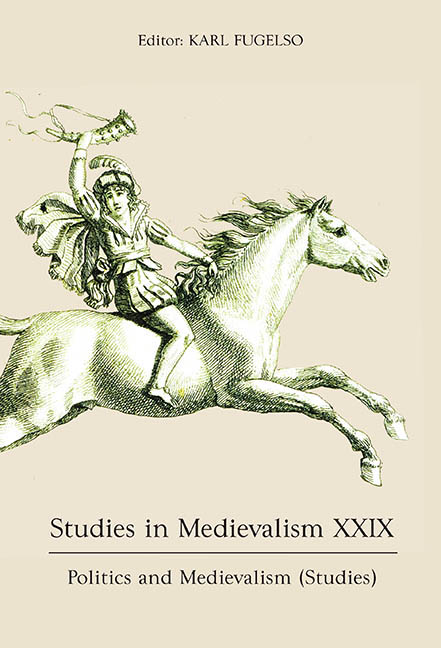Book contents
- Frontmatter
- Studies in Medievalism
- Acknowledgments
- Contents
- List of Illustrations
- Preface
- I Essays on Politics and Medievalism (Studies)
- Historical Malapropism and the Medieval Blood Libel in American Politics
- Putin’s Medieval Weapons in the War against Ukraine
- The Battle of Tours and the US Southern Border
- Medievalism, Brexit, and the Myth of Nations
- An Arthur for the Brexit Era: Joe Cornish’s The Kid Who Would be King
- II Other Responses to Medievalism
- Angle-ing for Arthur: Erasing the Welsh in Guy Ritchie’s King Arthur: Legend of the Sword
- Chasing Freyja: Rape, Immigration, and the Medieval in Alt-Right Discourse
- “Things painted on the coarse canvas”: Political Polemic in Jean-Paul Laurens’s Portrait of the Child Emperor Honorius
- Longfellow and Old English
- Archaeology and Medievalism at Julian of Norwich’s Anchorite Cell
- A Revelation of Love: Christianity, Julian of Norwich, and Medieval Pity in the Harry Potter Series
- In the Beginning Was the Word: How Medieval Text Became Fantasy Maps
- Objectivity, Impossibility, and Laughter in Doctor Who’s “Robot of Sherwood”
- Sonic Medievalism, World Building, and Cultural Identity in Fantasy Video Games
- Contributors
- Miscellaneous Endmatter
Archaeology and Medievalism at Julian of Norwich’s Anchorite Cell
Published online by Cambridge University Press: 19 August 2020
- Frontmatter
- Studies in Medievalism
- Acknowledgments
- Contents
- List of Illustrations
- Preface
- I Essays on Politics and Medievalism (Studies)
- Historical Malapropism and the Medieval Blood Libel in American Politics
- Putin’s Medieval Weapons in the War against Ukraine
- The Battle of Tours and the US Southern Border
- Medievalism, Brexit, and the Myth of Nations
- An Arthur for the Brexit Era: Joe Cornish’s The Kid Who Would be King
- II Other Responses to Medievalism
- Angle-ing for Arthur: Erasing the Welsh in Guy Ritchie’s King Arthur: Legend of the Sword
- Chasing Freyja: Rape, Immigration, and the Medieval in Alt-Right Discourse
- “Things painted on the coarse canvas”: Political Polemic in Jean-Paul Laurens’s Portrait of the Child Emperor Honorius
- Longfellow and Old English
- Archaeology and Medievalism at Julian of Norwich’s Anchorite Cell
- A Revelation of Love: Christianity, Julian of Norwich, and Medieval Pity in the Harry Potter Series
- In the Beginning Was the Word: How Medieval Text Became Fantasy Maps
- Objectivity, Impossibility, and Laughter in Doctor Who’s “Robot of Sherwood”
- Sonic Medievalism, World Building, and Cultural Identity in Fantasy Video Games
- Contributors
- Miscellaneous Endmatter
Summary
As the author of Revelations of Divine Love (or Book of Showings), Julian of Norwich (1342–c. 1416), has been hailed as “the most widely read and influential mystic of the English spiritual tradition, the encourager and consoler of thousands of people throughout the world,” and has inspired myriad portrayals of her as a feminist, conservative, and even ecologist. This intense interest in Julian of Norwich's life and writings is a postmedieval phenomenon and has drawn visitors from around the world to her anchorite cell at St. Julian's Church in Norwich, England. However, as Sarah Salih notes, the cell “is hyper-real, fitter for present purposes than the historical cell,” as it is a modern reconstruction designed to accommodate the contemplation needs and expectations of modern visitors in a city keenly stressing its heritage and to symbolize healing and reconciliation following the trauma of WWII.6 An archaeological investigation of Julian's cell thus offers a new lens through which to view not only the historical Julian but also the postmedieval responses to her and her texts.
As a medievalist trained in archaeology and specializing in the physical remains of anchoritic cells in England, my approach to viewing Julian's cell is different from a literature-focused approach. Sarah Salih discussed the layout of the modern cell and explained how its construction and use are designed “to generate and channel thoughts about the past.” Still, a scholarly assessment focusing on how the archaeological evidence is used in the creation of Julian's modern cell has not been articulated. Archaeological evidence is conceptualized differently than its literary counterparts, and this leads to an ambiguous position, where the archaeology is simultaneously considered a validation of objective historical reality, and interpreted as a medievalism within a literary framework. In anchoritic studies, anchoritic archaeology is almost always used as physical proof of literary sources, which portrays the archaeology as merely supportive of literary sources instead of offering an independent narrative of experience. Visitors to Julian's cell seek a genuine experience; Annette Krutziger-Herr described this kind of medievalism as reproductive, in that “medieval works are reconstructed in a way which the present regards as ‘authentic’.”
- Type
- Chapter
- Information
- Studies in Medievalism XXIXPolitics and Medievalism (Studies), pp. 123 - 154Publisher: Boydell & BrewerPrint publication year: 2020



